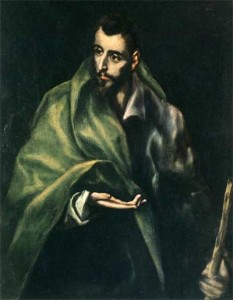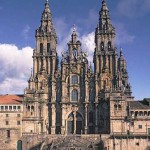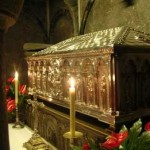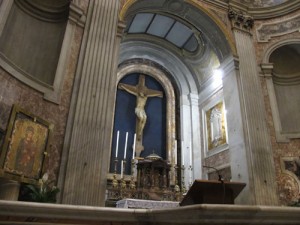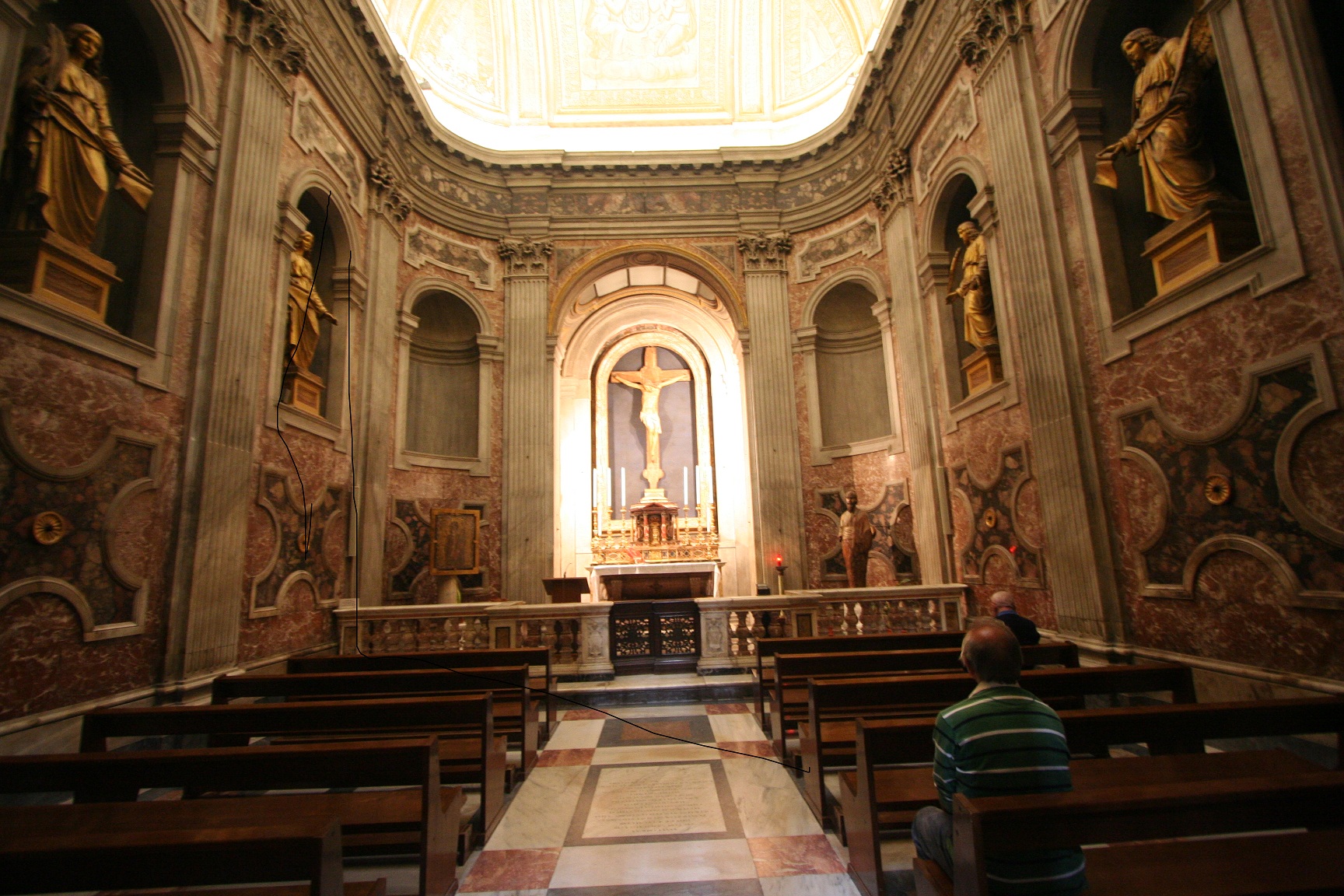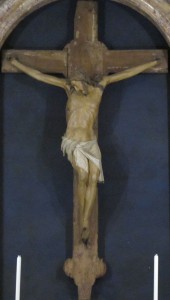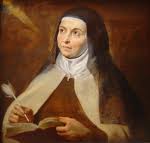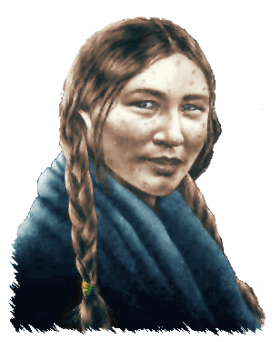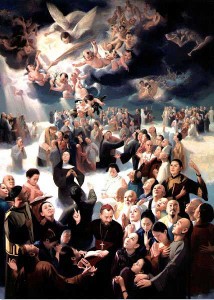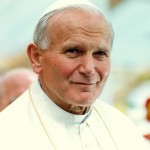BENEDICT XVI
GENERAL AUDIENCE
Wednesday, 21 June 2006
James, the Greater
We are continuing the series of portraits of the Apostles chosen directly by Jesus during his earthly life. We have spoken of St Peter and of his brother, Andrew. Today we meet the figure of James. The biblical lists of the Twelve mention two people with this name: James, son of Zebedee, and James, son of Alphaeus (cf. Mk 3: 17,18; Mt 10: 2-3), who are commonly distinguished with the nicknames “James the Greater” and “James the Lesser”.
These titles are certainly not intended to measure their holiness, but simply to state the different importance they receive in the writings of the New Testament and, in particular, in the setting of Jesus’ earthly life. Today we will focus our attention on the first of these two figures with the same name.
The name “James” is the translation of Iakobos, the Graecised form of the name of the famous Patriarch, Jacob. The Apostle of this name was the brother of John and in the above-mentioned lists, comes second, immediately after Peter, as occurs in Mark (3: 17); or in the third place, after Peter and Andrew as in the Gospels of Matthew (10: 2) and Luke (6: 14), while in the Acts he comes after Peter and John (1: 13). This James belongs, together with Peter and John, to the group of the three privileged disciples whom Jesus admitted to important moments in his life.
Since it is very hot today, I want to be brief and to mention here only two of these occasions. James was able to take part, together with Peter and John, in Jesus’ Agony in the Garden of Gethsemane and in the event of Jesus’ Transfiguration. Thus, it is a question of situations very different from each other: in one case, James, together with the other two Apostles, experiences the Lord’s glory and sees him talking to Moses and Elijah, he sees the divine splendour shining out in Jesus.
On the other occasion, he finds himself face to face with suffering and humiliation, he sees with his own eyes how the Son of God humbles himself, making himself obedient unto death. The latter experience was certainly an opportunity for him to grow in faith, to adjust the unilateral, triumphalist interpretation of the former experience: he had to discern that the Messiah, whom the Jewish people were awaiting as a victor, was in fact not only surrounded by honour and glory, but also by suffering and weakness. Christ’s glory was fulfilled precisely on the Cross, in his sharing in our sufferings.
This growth in faith was brought to completion by the Holy Spirit at Pentecost, so that James, when the moment of supreme witness came, would not draw back. Early in the first century, in the 40s, King Herod Agrippa, the grandson of Herod the Great, as Luke tells us, “laid violent hands upon some who belonged to the Church. He had James, the brother of John, killed by the sword” (Acts 12: 1-2).
The brevity of the news, devoid of any narrative detail, reveals on the one hand how normal it was for Christians to witness to the Lord with their own lives, and on the other, that James had a position of relevance in the Church of Jerusalem, partly because of the role he played during Jesus’ earthly existence.
A later tradition, dating back at least to Isidore of Seville, speaks of a visit he made
to Spain to evangelize that important region of the Roman Empire. According to another tradition, it was his body instead that had been taken to Spain, to the city of Santiago de Compostela. As we all know, that place became the object of great veneration and is still the destination of numerous pilgrimages, not only from Europe but from the whole world. This explains the iconographical representation of St James with the pilgrim’s staff and the scroll of the Gospel in hand, typical features of the travelling Apostle dedicated to the proclamation of the “Good News” and characteristics of the pilgrimage of Christian life.
Consequently, we can learn much from St James: promptness in accepting the Lord’s call even when he asks us to leave the “boat” of our human securities, enthusiasm in following him on the paths that he indicates to us over and above any deceptive presumption of our own, readiness to witness to him with courage, if necessary to the point of making the supreme sacrifice of life.
Thus James the Greater stands before us as an eloquent example of generous adherence to Christ. He, who initially had requested, through his mother, to be seated with his brother next to the Master in his Kingdom, was precisely the first to drink the chalice of the passion and to share martyrdom with the Apostles.
And, in the end, summarizing everything, we can say that the journey, not only exterior but above all interior, from the mount of the Transfiguration to the mount of the Agony, symbolizes the entire pilgrimage of Christian life, among the persecutions of the world and the consolations of God, as the Second Vatican Council says. In following Jesus, like St James, we know that even in difficulties we are on the right path.
Tags: apostle, martyr, pilgrimage, pope benedict xvi
This entry was posted on Wednesday, July 25th, 2012 at 8:49 am
You can follow any responses to this entry through the RSS 2.0 feed.
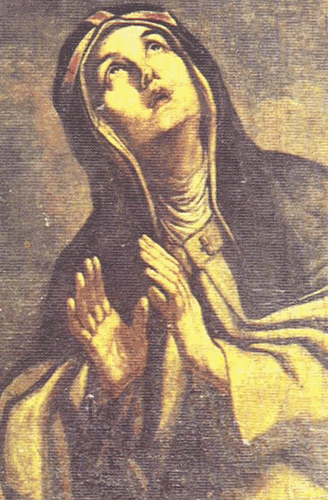 St. Bridget of Sweden…I never knew the power of the revelations to St. Bridget of Sweden until my friend Denise “reintroduced” them to me.  I say “reintroduced”, because I had bought the Pieta Prayer booklet (where they can be found) back in 1987. I offered them, really, only for a short while before packing the book away. But years later, after seeing how the revelations touched the heart of my
St. Bridget of Sweden…I never knew the power of the revelations to St. Bridget of Sweden until my friend Denise “reintroduced” them to me.  I say “reintroduced”, because I had bought the Pieta Prayer booklet (where they can be found) back in 1987. I offered them, really, only for a short while before packing the book away. But years later, after seeing how the revelations touched the heart of my dear friend, I dug the booklet out and started praying them again (as faithfully as I could). They are very powerful and beautiful. Meditating on the Passion of our Lord with the intensity called for in this particular devotion will change your life…are you ready?  How many of you out there have the Pieta prayer book and know the stories of St. Bridget of Sweden?
dear friend, I dug the booklet out and started praying them again (as faithfully as I could). They are very powerful and beautiful. Meditating on the Passion of our Lord with the intensity called for in this particular devotion will change your life…are you ready?  How many of you out there have the Pieta prayer book and know the stories of St. Bridget of Sweden?
(oh, be sure not to confuse her with St. Brigid of Kildare…it happens all the time)
Here  is the audio mp3 download of the 15 Prayers of St. Bridget as offered by Bruce McGregor and Denise Wharton
[powerpress ]
You can find the text for the prayers hereÂ
Here is the chapel in St. Paul’s Outside the Walls in Rome where St. Bridget received the private revelation of the 15 prayers…….
Of course, St. Bridget is more than just her prayers…ordinary woman, extraordinary life!. To learn more about St. Bridget of Sweden, take a look at this:
Tags: audio, feast day, Pieta Prayer, pieta prayer book, prayers, rome, st bridget of sweden, St. Paul Outside the Walls, Sweden, women of the middle ages
This entry was posted on Monday, July 23rd, 2012 at 1:00 am
You can follow any responses to this entry through the RSS 2.0 feed.
[powerpress]
This entry was posted on Wednesday, July 18th, 2012 at 7:12 pm
You can follow any responses to this entry through the RSS 2.0 feed.
[powerpress]
This entry was posted on Wednesday, July 18th, 2012 at 7:09 pm
You can follow any responses to this entry through the RSS 2.0 feed.
[powerpress]
This entry was posted on Wednesday, July 18th, 2012 at 6:35 pm
You can follow any responses to this entry through the RSS 2.0 feed.
[powerpress]
This entry was posted on Wednesday, July 18th, 2012 at 6:31 pm
You can follow any responses to this entry through the RSS 2.0 feed.
[powerpress]
This entry was posted on Wednesday, July 18th, 2012 at 6:27 pm
You can follow any responses to this entry through the RSS 2.0 feed.
[powerpress]
This entry was posted on Wednesday, July 18th, 2012 at 6:26 pm
You can follow any responses to this entry through the RSS 2.0 feed.
[powerpress]
This entry was posted on Wednesday, July 18th, 2012 at 6:24 pm
You can follow any responses to this entry through the RSS 2.0 feed.
[powerpress]
This entry was posted on Wednesday, July 18th, 2012 at 6:20 pm
You can follow any responses to this entry through the RSS 2.0 feed.
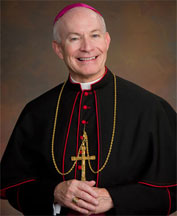 [powerpress]
[powerpress]
This entry was posted on Wednesday, July 18th, 2012 at 6:18 pm
You can follow any responses to this entry through the RSS 2.0 feed.
Bl. Teresa of St. Augustine and Companions (OCD), Virgins and Martyrs (m)
“These were a community of sixteen Discalced Carmelite nuns from the monastery of the Incarnation at Compiégne in France. When the full terror of the French Revolution began, they offered themselves as sacrificial victims to beg God for peace for the Church and for their country. Arrested and imprisoned on the 24th June 1794, they continued to share their joy and their faith with others. Condemned to death for their loyalty to the Church, to their religious vows and for their devotion to the Sacred Hearts of Jesus and Mary, they were guillotined in Paris on 17th July 1794 whilst singing hymns
and after having renewed their vows to their prioress, Teresa of St. Augustine. They were beatified by Saint Pius X on 13th May 1906.” from The Carmelite website
If you get a chance, listen to the beautifully provocative opera by Poulenc entitled “The Dialogues des Carmelites”…it’s stunning! The finale makes me cry every single time…(they are singing the Salve Regina, aka the Hail Holy Queen)
Take a look
Tags: carmelites. martyrs, french revolution, opera, poulenc
This entry was posted on Tuesday, July 17th, 2012 at 12:51 am
You can follow any responses to this entry through the RSS 2.0 feed.
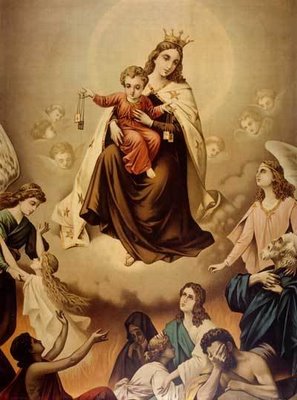 The Feast of Our Lady of Mount Carmel…
The Feast of Our Lady of Mount Carmel…
A prayer to Our Lady of Mt. Carmel
[powerpress]
from About.com
“According to the traditions of the Carmelite order, on July 16, 1251, the Blessed Virgin Mary appeared to St. Simon Stock, a Carmelite. During the vision, she revealed to him the Scapularof Our Lady of Mount Carmel, popularly known as the “Brown Scapular.” A century and a quarter later, the Carmelite order began to celebrate on this date the Feast of Our Lady of Mount Carmel.
The Carmelites had long claimed that their order extended back to ancient times-indeed, that it was founded on Mount Carmel in Palestine by the prophets Elijah and Elisha. While others disputed this idea, Pope Honorius III, in approving the order in 1226, seemed to accept its antiquity. The celebration of the feast became wrapped up with this controversy, and, in 1609, after Robert Cardinal Bellarmine examined the origins of the feast, it was declared the patronal feast of the Carmelite order.
The feast celebrates the devotion that the Blessed Virgin Mary has to those who are devoted to her, and who signal that devotion by wearing the Brown Scapular. According to tradition, those who wear the scapular faithfully and remain devoted to the Blessed Virgin until death will be granted the grace of final perseverance and be delivered from Purgatory early.”
I’m all about the cloth scapular rather than the medal or wood ones. It’s intent is to be a habit…who wears metal or wood clothing? I realize papal permission was given to wear the medal instead, but that was for missionaries in the jungle where the climate disintigrated the cloth quickly.  Really, would it really be a big problem, for those committed to the devotion, to wear the cloth scapular for solidarity sake?  Anyway…
Here are a few of the Carmelites dearest to our hearts:
Also THE SIXTEEN CARMELITE MARTYRS OF COMPIEGNE, but that’s tomorrow….
Tags: blessed virgin mary, brown scapular, catholic, catholic podcast, catholic prayer, cathollc spirituality, devotion, lady of mount carmel, Simon Stock
This entry was posted on Monday, July 16th, 2012 at 12:07 am
You can follow any responses to this entry through the RSS 2.0 feed.
Kaia’tanó:ron – Blessed
Kateri Tekakwitha
Gah-deh-lee   Deh-gah-quee-tah
Flower of the Algonguins – Lily of the Mohawks
1656-1680
Feast Day
July 14 in the United States
Blessed Kateri, you are revered as the mystic of the American wilderness. Though orphaned at the age of four, and left with a scarred face and damaged eyesight from illness, you were esteemed among the Mohawk tribe. When you asked to be baptized a Christian, you subjected yourself to abuse by your people and were forced to run away. You endured many trials but still flowered in prayer and holiness, dedicating yourself totally to Christ. I ask you to be my spiritual guide along my journey through life. Through your intercession, I pray that I may always be loyal to my faith in all things. Amen.
Tags: blessed kateri Tekakwitha, catholic, catholic podcast, catholic prayer, cathollc spirituality, lily of the mohawks
This entry was posted on Saturday, July 14th, 2012 at 7:41 am
You can follow any responses to this entry through the RSS 2.0 feed.
Sunday 1 October 2000 (excerpt taken from vatican.va)
2. “The precepts of the Lord give joy to the heart” (Responsorial Psalm). These words of the Responsorial Psalm clearly reflect the experience of Augustine Zhao Rong and his 119 companions, martyrs in China. The testimonies which have come down to us allow us to glimpse in them a state of mind marked by deep serenity and joy.
Today the Church is grateful to her Lord, who blesses her and bathes her in light with the radiant holiness of these sons and daughters of China. Is not the Holy Year the most appropriate moment to make their heroic witness shine resplendently? Young Ann Wang, a 14-year-old, withstood the threats of the torturers who invited her to apostatize. Ready for her beheading, she declared with a radiant face: “The door of heaven is open to all”, three times murmuring: “Jesus”. And 18-year-old Chi Zhuzi, cried out fearlessly to those who had just cut off his right arm and were preparing to flay him alive: “Every piece of my flesh, every drop of my blood will tell you that I am Christian”.
The other 85 Chinese men and women of every age and state, priests, religious and lay people, showed the same conviction and joy, sealing their unfailing fidelity to Christ and the Church with the gift of their lives. This occurred over the course of several centuries and in a complex and difficult era of China’s history. Today’s celebration is not the appropriate time to pass judgement on those historical periods: this can and should be done elsewhere. Today, with this solemn proclamation of holiness, the Church intends merely to recognize that those martyrs are an example of courage and consistency to us all, and that they honour the noble Chinese people.
Resplendent in this host of martyrs are also the 33 missionaries who left their land and sought to immerse themselves in the Chinese world, lovingly assimilating its features in the desire to proclaim Christ and to serve those people. Their tombs are there as if to signify their definitive belonging to China, which they deeply loved, although with their human limitations, and for which they spent all their energies. “We never wronged anyone”, Bishop Francis Fogolla replied to the governor who was preparing to strike him with his sword. “On the contrary, we have done good to many”. (In Chinese) God sends down happiness.
Tags: Augustine Zhao Rong, catholic, catholic podcast, catholic prayer, cathollc spirituality, china, Church in China HOMILY, martyrdom, martyrs, martyrs in China, Responsorial Psalm, St. Augustine Zhao Rong
This entry was posted on Monday, July 9th, 2012 at 8:09 am
You can follow any responses to this entry through the RSS 2.0 feed.

